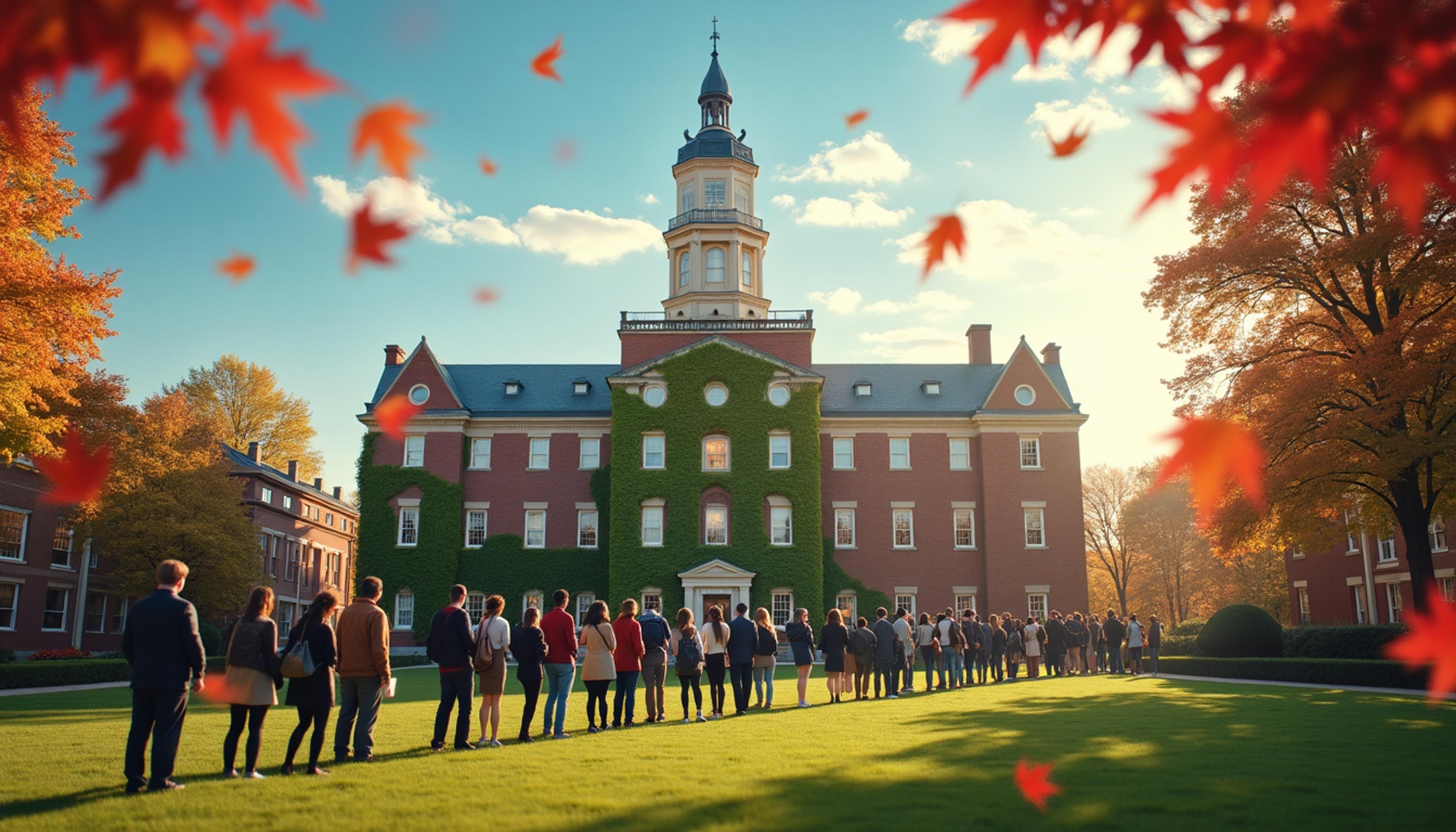Harvard Waitlist - What it Is and How to Get Off
Learn about Harvard's waitlist process, acceptance odds, and strategies to increase chances. This guide includes tips on how to respond, write a compelling letter of continued interest, and balance hope with practical backup plans.
Posted March 6, 2025

Table of Contents
Every year, thousands of qualified students get news that they've been placed on the Harvard waitlist. These students find themselves caught between acceptance and rejection. Harvard uses its waitlist to manage incoming class sizes and ensure a diverse, cohesive class, while also keeping its position among the world's most selective schools.
This complete guide explains the Harvard waitlist process and will help you understand the actual chances of getting from the waitlist. You’ll also find essential tips that could help you turn a waitlist status into an acceptance.
What is the Harvard Waitlist?
The Harvard waitlist is a list of applicants who are being considered for admission, but aren't immediately accepted due to limited space. These candidates are offered a spot on the waitlist, giving them a chance to be admitted if spots open up later in the admissions cycle. Being waitlisted at Harvard is common, and students on the list may be asked to provide additional information to strengthen their applications.
A spot on the Harvard waitlist stands as an achievement on its own. It shows that a student made it through Harvard's tough initial screening process. Unlike a rejection, a waitlist spot means Harvard sees the student's potential but can't offer admission right away because of space limits.
Harvard uses the waitlist as a way to manage its class size. This helps them keep their high standards while making sure they fill their incoming class. With approximately 60,000 applications coming in yearly, the waitlist helps balance the class makeup and hit enrollment targets. The system lets Harvard adjust its final class based on what they need, from academic interests to geographic diversity and specific talents.
On its site, Harvard says: “Our wait list includes the applicants whom the Committee might still wish to consider for admission if spots in the entering class open later. The waitlist is not ranked.”

Harvard Waitlist Acceptance Rate
Harvard's waitlist admission chances remain challenging to predict because the university keeps its waitlist statistics private. In addition, the number accepted off the waitlist varies dramatically from year to year, depending on what the applicant pool looks like and the percentage of those admitted who choose to enroll (the yield rate). The school itself has stated, “In some years, we have admitted no one from the wait list; in others, we have admitted more than 200 candidates.”
Harvard's waitlist admissions have been estimated at the following for the last few years.
| Graduating Class Year | # of Applications | Acceptance Rate | # of Students Accepted Off the Waitlist | Yield |
|---|---|---|---|---|
| 2024 | 40,248 | 4.92% | 34 | 81% |
| 2025 | 57,435 | 3.43% | 0 | 85% |
| 2026 | 61,220 | 3.19% | 36 | 83% |
How Many Students Choose to Attend Harvard
Of the approximately 1,950 students Harvard accepts each year, around 1,660 actually enroll, leading to a high yield rate of over 80%. This figure means Harvard typically needs only 10 to 15 more students from the waitlist to reach its target class size, depending on year-to-year enrollment fluctuations. Harvard’s yield rate impacts the number of waitlisted students who ultimately gain admission, with variations in admissions each year depending on class composition goals and available space. As a result, many waitlisted candidates pursue enrollment at other schools to ensure they have secure options.

Factors That Influence Waitlist Decisions
The admissions committee reviews candidates who are waitlisted by Harvard based on several institutional needs. Here's what matters:
- Overall application strength compared to other waitlisted candidates
- New accomplishments or achievements added
- A balanced class composition requirement
- Available financial aid funds, since most resources go to students accepted in the first round
Keep in mind that a Harvard waitlist doesn't follow a ranking system, which means there's no fixed order when reviewing college applicants.
Yield Rate Effect
Harvard's exceptionally high yield rate can also affect waitlist decisions The yield for the Class of 2027 reached just above 84%. Students accept Harvard's offers at a rate above 80% consistently, which leaves very few spots for waitlist candidates.
Highly selective schools like Harvard send about 1,950 additional letters of acceptance to fill a class of 1,660 students. This means only 34 to 44 spots might open up for waitlisted candidates. The actual number drops even lower, usually between 10 to 15 spots. Students waitlisted by Harvard face tough odds since acceptance rates from the wait list stay in single digits during admission cycles.
Steps to Take for Waitlisted Students
A Harvard waitlist decision demands strategic action instead of passive waiting, and students who receive this offer should follow several significant steps to improve their admission chances.
Accept a spot at another school
Waitlisted students must secure their future by putting down an enrollment deposit at another institution. The deposit is typically non-refundable but guarantees a spot in that college's first-year class. Students should take this crucial step whatever their hopes are of attending Harvard.
Opt-in to remain on the waitlist
Students need to actively choose to stay on the Harvard waitlist by submitting the Waitlist Response Form through their status checker. Harvard's waitlist has no rankings, which means each waitlisted student has an equal chance for admission based on the institution's needs and class composition.

Write a compelling letter of continued interest
A letter of continued interest (LOCI) plays a significant role for waitlisted candidates. The letter should include these key elements:
- A clear statement that shows ongoing interest in Harvard
- Updates about recent achievements or awards
- Specific reasons to attend Harvard
- A confirmation that Harvard remains a top choice (if true)
- A genuine thank you note for the waitlist consideration
Keep the LOCI professional and concise within one page. Students should not mention their acceptance to other institutions because this might reduce their chances of admission.
Keep your grades up (and consider retaking the ACT/SAT)
Academic performance is significant during the waitlist period. Students should demonstrate their dedication to excellence in studies because admissions may review final semester grades when they activate the waitlist. A strong academic record strengthens the student’s candidacy and shows that they are ready for college-level coursework. If you have the time, consider retaking the ACT/SAT. If you get a better score, you can send that as an update to Harvard’s AdCom to make you more competitive against other applicants they may be considering.
Students should communicate professionally with the admissions office throughout the waitlist process. They need to show interest without making excessive contact and share only meaningful updates or achievements.
What Not to Do When Waitlisted
Getting accepted from Harvard's waitlist depends on smart strategies and avoiding common mistakes. Students who show too much enthusiasm might actually decrease their admission chances.
Don't pester the admissions office
Admissions offices process thousands of applications each year. Excessive communication might work against a candidate. Students should only reach out with important updates and information that the office requests. The admissions team strongly discourages:
- Sending multiple follow-up emails or making repeated calls
- Constantly asking about application status
- Reaching out to different staff members with the same request
- Trying to set up meetings without proper authorization
Avoid gimmicks or over-the-top gestures
Creative approaches might seem like a good way to stand out, but dramatic gestures rarely help applicants. Every year, students attempt bold moves to capture attention, but these efforts have consistently proven unsuccessful. The admissions committee strongly advises against:
Unsolicited gifts or promotional materials can damage an application's chances. Professional communication continues to work best, even when certain actions aren't specifically forbidden.
Don't neglect backup plans
The most critical mistake waitlisted students make is focusing only on Harvard and ignoring other chances. A waitlist acceptance rate varies dramatically each year. Candidates need to keep a balanced view and note that success isn't limited to one institution. The admissions office strongly recommends waitlisted candidates to:
- Accept admission offers from other schools
- Submit enrollment deposits by standard deadlines
- Connect with alternate college communities
- Keep up their grades at current institutions
The waitlist gives a chance but not a guarantee. Students naturally hope for admission, but they should be practical and not put their academic future on hold while waiting for Harvard's decision.
Conclusion
The Harvard waitlist serves as a sophisticated admissions tool that helps the university maintain its selective standards and manage class composition effectively. The acceptance rate has varied drastically over the last several years - from zero to several dozen students. This unpredictable nature makes it challenging for students who got waitlisted by Harvard to navigate through professional communication channels, excel academically, and provide strategic updates to their applications.
For the best chance of turning a Harvard waitlist status into an acceptance, get expert guidance from top school admission coaches.
FAQs
How does the Harvard waitlist work?
- When Harvard places you on their waitlist, it means they are interested in your application but haven't offered you a spot yet. Being on the waitlist is not a guarantee of admission, but it does mean that you're still in the running.
Is getting waitlisted at Harvard good?
- First, congratulations on being waitlisted at Harvard! Although it's not an acceptance, it is still an impressive accomplishment, as many talented students apply.
What percentage of waitlisted students get accepted at Harvard?
- Over the last 30 years, about 39% of students who come to Ivy Coach after being waitlisted by Harvard earn admission (photo credit: Chensiyuan). If you've been waitlisted for Harvard University's Class of 2028, you might wonder if you've got a legitimate chance of admission.
Is it possible to get off the Harvard waitlist?
- While the specific number of applicants admitted from the waitlist can vary each year, there are steps you can take to increase your chances of getting off the waitlist. Accept your spot on the waitlist, explore other college options as a backup plan, and consider sending a well-crafted letter of continued interest.
Can you appeal a rejection from Harvard?
- Some colleges, especially major private schools, do not consider appeals for any reason. Harvard, Yale, Stanford, and Columbia, among many others, fall into this category. If one of these schools denies you admission, all you can do is accept the rejection with grace and move on.
Does Harvard defer or reject?
- Some years Harvard chooses to release the data point, while other years, the Ivy League schools keep it close to the vest. But, historically, most students not offered admission to Harvard's incoming class in the Early Action round are deferred rather than denied outright.
Can I get into Harvard in my 30s?
- There is no age requirement for applying to Harvard, though applicants are expected to have some secondary school experience.
Does Harvard care about test scores?
- We will evaluate your application noting the highest test scores in each section across test dates for the SAT and your strongest sitting for the ACT. We take into account your educational background when reviewing your scores. You may choose to send your ACT super scores to Harvard.
How do I respond to a waitlist email?
- Make sure to respond to the waitlist email as soon as possible, ideally within a day or two. In your response, thank the admissions office for considering your application and express that you're still excited about the possibility of attending the college.
What is the waitlist strategy?
- A waitlist builds anticipation for your upcoming product by showing people they may have to wait to gain access. This taps into the psychological principle of scarcity - when something seems rare or limited in availability, people tend to want it more.



















